differential CHEVROLET HHR 2008 1.G Owners Manual
[x] Cancel search | Manufacturer: CHEVROLET, Model Year: 2008, Model line: HHR, Model: CHEVROLET HHR 2008 1.GPages: 430, PDF Size: 5.63 MB
Page 213 of 430
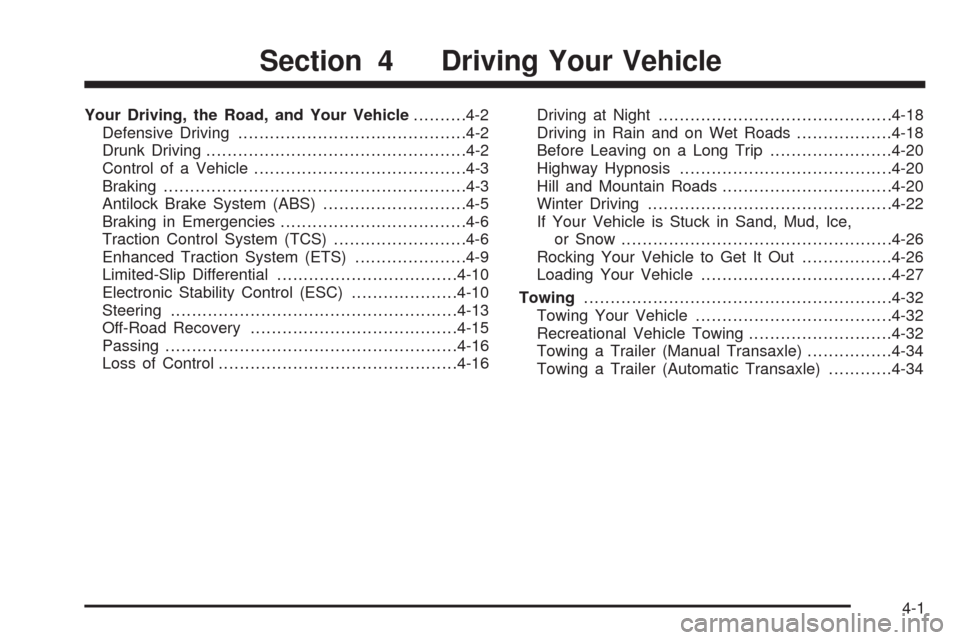
Your Driving, the Road, and Your Vehicle..........4-2
Defensive Driving...........................................4-2
Drunk Driving.................................................4-2
Control of a Vehicle........................................4-3
Braking.........................................................4-3
Antilock Brake System (ABS)...........................4-5
Braking in Emergencies...................................4-6
Traction Control System (TCS).........................4-6
Enhanced Traction System (ETS).....................4-9
Limited-Slip Differential..................................4-10
Electronic Stability Control (ESC)....................4-10
Steering......................................................4-13
Off-Road Recovery.......................................4-15
Passing.......................................................4-16
Loss of Control.............................................4-16Driving at Night............................................4-18
Driving in Rain and on Wet Roads..................4-18
Before Leaving on a Long Trip.......................4-20
Highway Hypnosis........................................4-20
Hill and Mountain Roads................................4-20
Winter Driving..............................................4-22
If Your Vehicle is Stuck in Sand, Mud, Ice,
or Snow...................................................4-26
Rocking Your Vehicle to Get It Out.................4-26
Loading Your Vehicle....................................4-27
Towing..........................................................4-32
Towing Your Vehicle.....................................4-32
Recreational Vehicle Towing...........................4-32
Towing a Trailer (Manual Transaxle)................4-34
Towing a Trailer (Automatic Transaxle)............4-34
Section 4 Driving Your Vehicle
4-1
Page 220 of 430
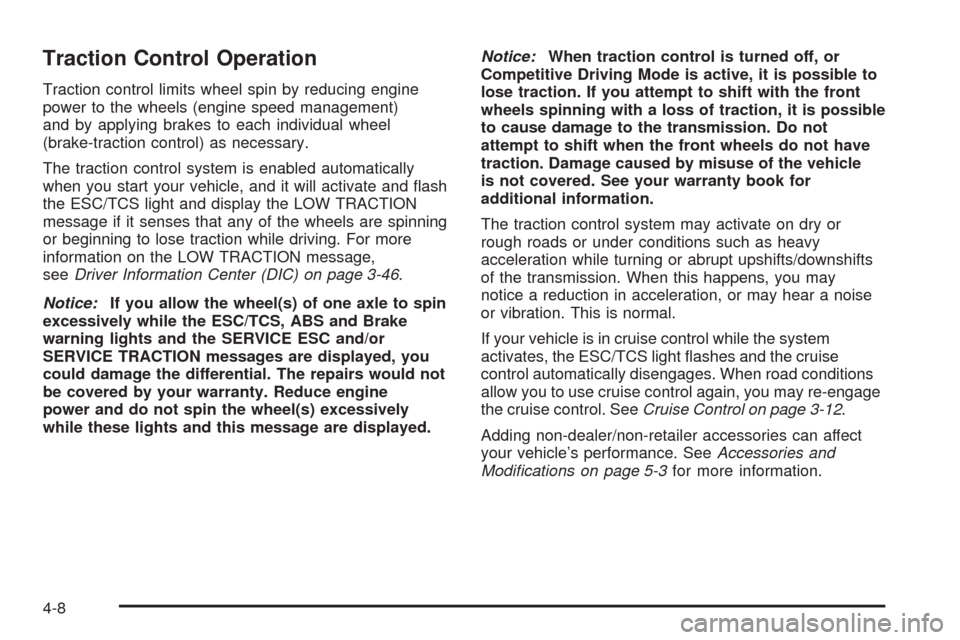
Traction Control Operation
Traction control limits wheel spin by reducing engine
power to the wheels (engine speed management)
and by applying brakes to each individual wheel
(brake-traction control) as necessary.
The traction control system is enabled automatically
when you start your vehicle, and it will activate and �ash
the ESC/TCS light and display the LOW TRACTION
message if it senses that any of the wheels are spinning
or beginning to lose traction while driving. For more
information on the LOW TRACTION message,
seeDriver Information Center (DIC) on page 3-46.
Notice:If you allow the wheel(s) of one axle to spin
excessively while the ESC/TCS, ABS and Brake
warning lights and the SERVICE ESC and/or
SERVICE TRACTION messages are displayed, you
could damage the differential. The repairs would not
be covered by your warranty. Reduce engine
power and do not spin the wheel(s) excessively
while these lights and this message are displayed.Notice:When traction control is turned off, or
Competitive Driving Mode is active, it is possible to
lose traction. If you attempt to shift with the front
wheels spinning with a loss of traction, it is possible
to cause damage to the transmission. Do not
attempt to shift when the front wheels do not have
traction. Damage caused by misuse of the vehicle
is not covered. See your warranty book for
additional information.
The traction control system may activate on dry or
rough roads or under conditions such as heavy
acceleration while turning or abrupt upshifts/downshifts
of the transmission. When this happens, you may
notice a reduction in acceleration, or may hear a noise
or vibration. This is normal.
If your vehicle is in cruise control while the system
activates, the ESC/TCS light �ashes and the cruise
control automatically disengages. When road conditions
allow you to use cruise control again, you may re-engage
the cruise control. SeeCruise Control on page 3-12.
Adding non-dealer/non-retailer accessories can affect
your vehicle’s performance. SeeAccessories and
Modifications on page 5-3for more information.
4-8
Page 222 of 430
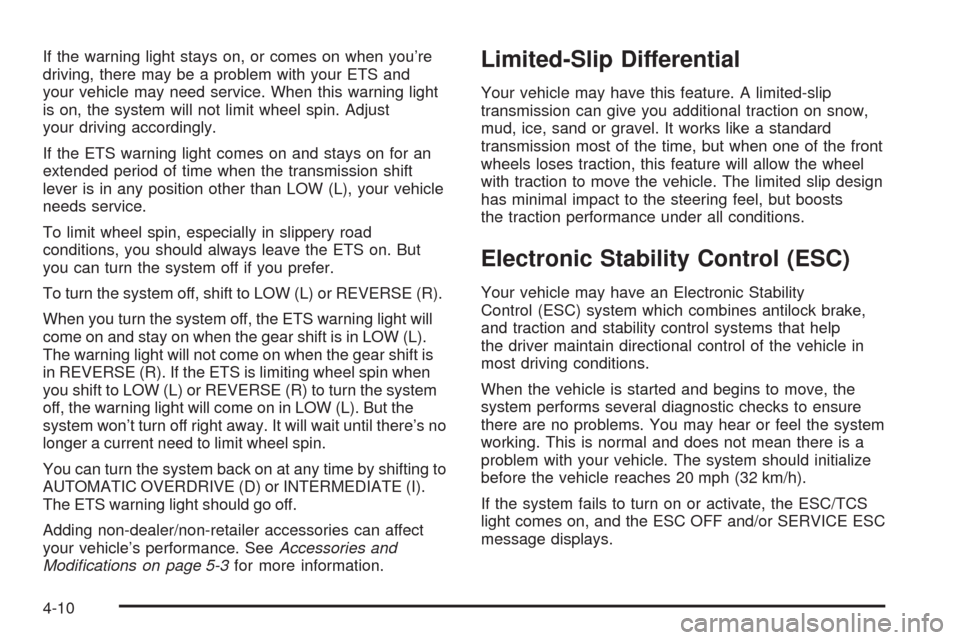
If the warning light stays on, or comes on when you’re
driving, there may be a problem with your ETS and
your vehicle may need service. When this warning light
is on, the system will not limit wheel spin. Adjust
your driving accordingly.
If the ETS warning light comes on and stays on for an
extended period of time when the transmission shift
lever is in any position other than LOW (L), your vehicle
needs service.
To limit wheel spin, especially in slippery road
conditions, you should always leave the ETS on. But
you can turn the system off if you prefer.
To turn the system off, shift to LOW (L) or REVERSE (R).
When you turn the system off, the ETS warning light will
come on and stay on when the gear shift is in LOW (L).
The warning light will not come on when the gear shift is
in REVERSE (R). If the ETS is limiting wheel spin when
you shift to LOW (L) or REVERSE (R) to turn the system
off, the warning light will come on in LOW (L). But the
system won’t turn off right away. It will wait until there’s no
longer a current need to limit wheel spin.
You can turn the system back on at any time by shifting to
AUTOMATIC OVERDRIVE (D) or INTERMEDIATE (I).
The ETS warning light should go off.
Adding non-dealer/non-retailer accessories can affect
your vehicle’s performance. SeeAccessories and
Modifications on page 5-3for more information.Limited-Slip Differential
Your vehicle may have this feature. A limited-slip
transmission can give you additional traction on snow,
mud, ice, sand or gravel. It works like a standard
transmission most of the time, but when one of the front
wheels loses traction, this feature will allow the wheel
with traction to move the vehicle. The limited slip design
has minimal impact to the steering feel, but boosts
the traction performance under all conditions.
Electronic Stability Control (ESC)
Your vehicle may have an Electronic Stability
Control (ESC) system which combines antilock brake,
and traction and stability control systems that help
the driver maintain directional control of the vehicle in
most driving conditions.
When the vehicle is started and begins to move, the
system performs several diagnostic checks to ensure
there are no problems. You may hear or feel the system
working. This is normal and does not mean there is a
problem with your vehicle. The system should initialize
before the vehicle reaches 20 mph (32 km/h).
If the system fails to turn on or activate, the ESC/TCS
light comes on, and the ESC OFF and/or SERVICE ESC
message displays.
4-10
Page 420 of 430
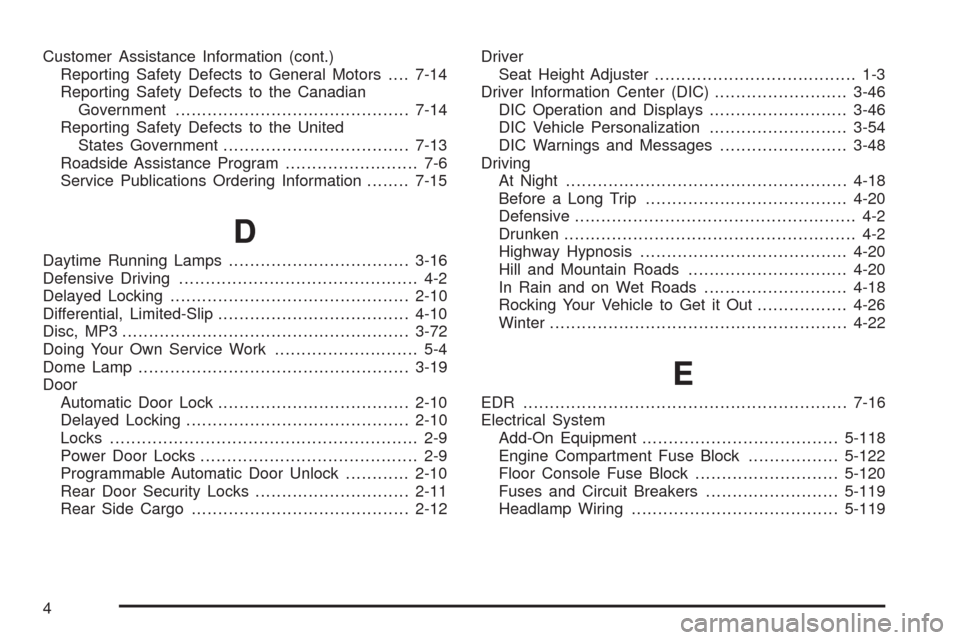
Customer Assistance Information (cont.)
Reporting Safety Defects to General Motors....7-14
Reporting Safety Defects to the Canadian
Government............................................7-14
Reporting Safety Defects to the United
States Government...................................7-13
Roadside Assistance Program......................... 7-6
Service Publications Ordering Information........7-15
D
Daytime Running Lamps..................................3-16
Defensive Driving............................................. 4-2
Delayed Locking.............................................2-10
Differential, Limited-Slip....................................4-10
Disc, MP3......................................................3-72
Doing Your Own Service Work........................... 5-4
Dome Lamp...................................................3-19
Door
Automatic Door Lock....................................2-10
Delayed Locking..........................................2-10
Locks.......................................................... 2-9
Power Door Locks......................................... 2-9
Programmable Automatic Door Unlock............2-10
Rear Door Security Locks.............................2-11
Rear Side Cargo.........................................2-12Driver
Seat Height Adjuster...................................... 1-3
Driver Information Center (DIC).........................3-46
DIC Operation and Displays..........................3-46
DIC Vehicle Personalization..........................3-54
DIC Warnings and Messages........................3-48
Driving
At Night.....................................................4-18
Before a Long Trip......................................4-20
Defensive..................................................... 4-2
Drunken....................................................... 4-2
Highway Hypnosis.......................................4-20
Hill and Mountain Roads..............................4-20
In Rain and on Wet Roads...........................4-18
Rocking Your Vehicle to Get it Out.................4-26
Winter........................................................4-22
E
EDR .............................................................7-16
Electrical System
Add-On Equipment.....................................5-118
Engine Compartment Fuse Block.................5-122
Floor Console Fuse Block...........................5-120
Fuses and Circuit Breakers.........................5-119
Headlamp Wiring.......................................5-119
4
Page 424 of 430
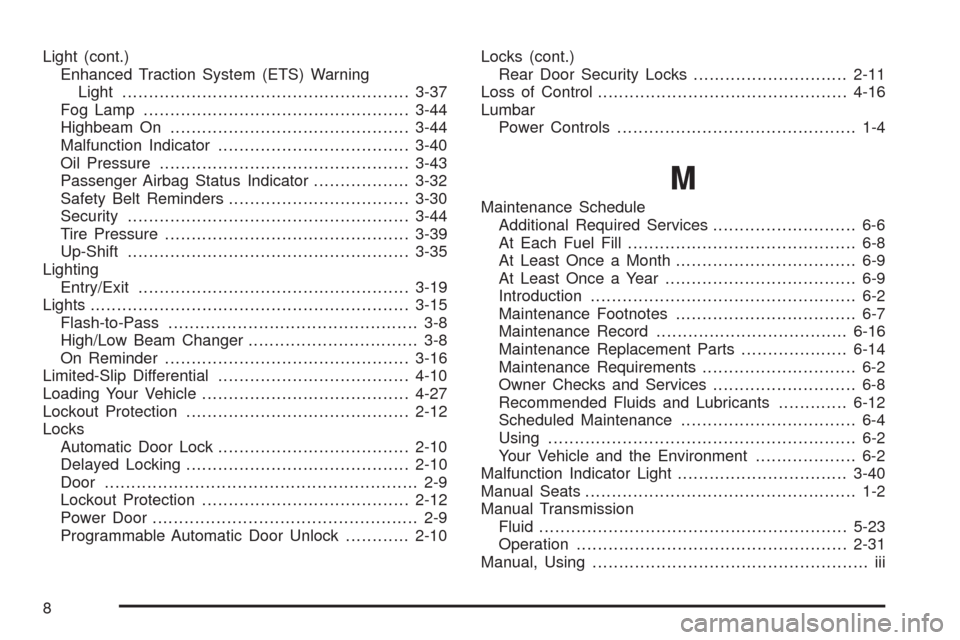
Light (cont.)
Enhanced Traction System (ETS) Warning
Light......................................................3-37
Fog Lamp..................................................3-44
Highbeam On.............................................3-44
Malfunction Indicator....................................3-40
Oil Pressure...............................................3-43
Passenger Airbag Status Indicator..................3-32
Safety Belt Reminders..................................3-30
Security.....................................................3-44
Tire Pressure..............................................3-39
Up-Shift.....................................................3-35
Lighting
Entry/Exit...................................................3-19
Lights............................................................3-15
Flash-to-Pass............................................... 3-8
High/Low Beam Changer................................ 3-8
On Reminder..............................................3-16
Limited-Slip Differential....................................4-10
Loading Your Vehicle.......................................4-27
Lockout Protection..........................................2-12
Locks
Automatic Door Lock....................................2-10
Delayed Locking..........................................2-10
Door........................................................... 2-9
Lockout Protection.......................................2-12
Power Door.................................................. 2-9
Programmable Automatic Door Unlock............2-10Locks (cont.)
Rear Door Security Locks.............................2-11
Loss of Control...............................................4-16
Lumbar
Power Controls............................................. 1-4
M
Maintenance Schedule
Additional Required Services........................... 6-6
At Each Fuel Fill........................................... 6-8
At Least Once a Month.................................. 6-9
At Least Once a Year.................................... 6-9
Introduction.................................................. 6-2
Maintenance Footnotes.................................. 6-7
Maintenance Record....................................6-16
Maintenance Replacement Parts....................6-14
Maintenance Requirements............................. 6-2
Owner Checks and Services........................... 6-8
Recommended Fluids and Lubricants.............6-12
Scheduled Maintenance................................. 6-4
Using.......................................................... 6-2
Your Vehicle and the Environment................... 6-2
Malfunction Indicator Light................................3-40
Manual Seats................................................... 1-2
Manual Transmission
Fluid..........................................................5-23
Operation...................................................2-31
Manual, Using.................................................... iii
8
Page 429 of 430
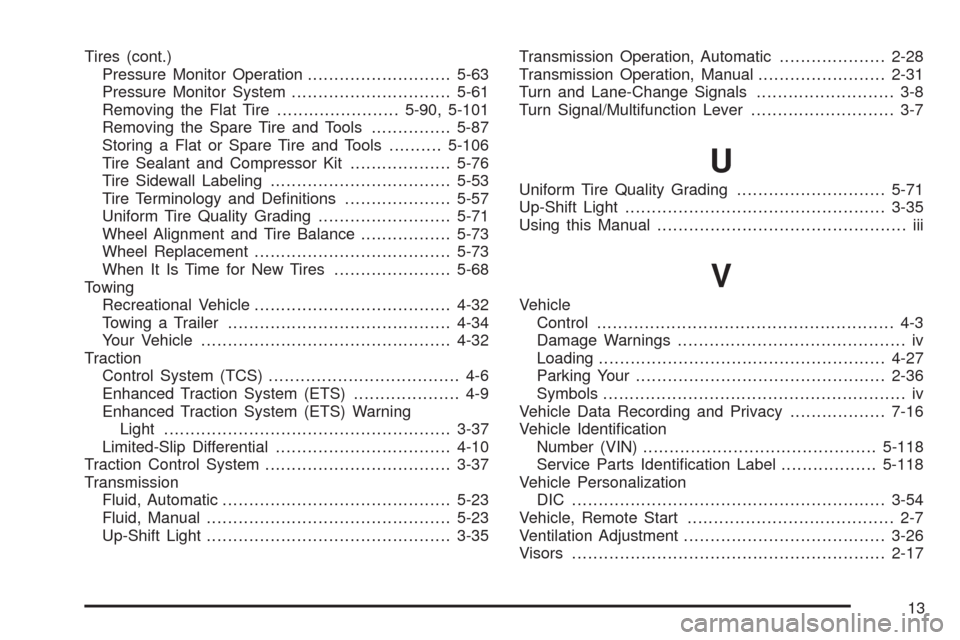
Tires (cont.)
Pressure Monitor Operation...........................5-63
Pressure Monitor System..............................5-61
Removing the Flat Tire.......................5-90, 5-101
Removing the Spare Tire and Tools...............5-87
Storing a Flat or Spare Tire and Tools..........5-106
Tire Sealant and Compressor Kit...................5-76
Tire Sidewall Labeling..................................5-53
Tire Terminology and De�nitions....................5-57
Uniform Tire Quality Grading.........................5-71
Wheel Alignment and Tire Balance.................5-73
Wheel Replacement.....................................5-73
When It Is Time for New Tires......................5-68
Towing
Recreational Vehicle.....................................4-32
Towing a Trailer..........................................4-34
Your Vehicle...............................................4-32
Traction
Control System (TCS).................................... 4-6
Enhanced Traction System (ETS).................... 4-9
Enhanced Traction System (ETS) Warning
Light......................................................3-37
Limited-Slip Differential.................................4-10
Traction Control System...................................3-37
Transmission
Fluid, Automatic...........................................5-23
Fluid, Manual..............................................5-23
Up-Shift Light..............................................3-35Transmission Operation, Automatic....................2-28
Transmission Operation, Manual........................2-31
Turn and Lane-Change Signals.......................... 3-8
Turn Signal/Multifunction Lever........................... 3-7
U
Uniform Tire Quality Grading............................5-71
Up-Shift Light.................................................3-35
Using this Manual............................................... iii
V
Vehicle
Control........................................................ 4-3
Damage Warnings........................................... iv
Loading......................................................4-27
Parking Your...............................................2-36
Symbols......................................................... iv
Vehicle Data Recording and Privacy..................7-16
Vehicle Identi�cation
Number (VIN)............................................5-118
Service Parts Identi�cation Label..................5-118
Vehicle Personalization
DIC ...........................................................3-54
Vehicle, Remote Start....................................... 2-7
Ventilation Adjustment......................................3-26
Visors...........................................................2-17
13